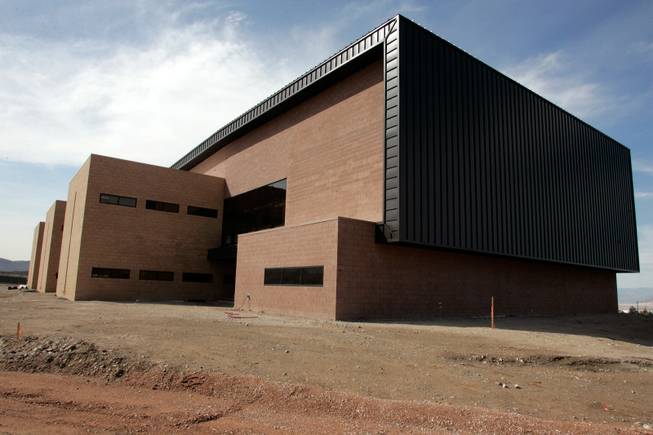
Nevada State College’s $23.4 million, 42,000-square-foot liberal arts and sciences building will house classrooms, offices and a student lounge. Faculty members are expected to start moving in this summer.
Saturday, March 15, 2008 | 2 a.m.
Sun Archives
- 'Howdy, pardner,’ colleges saying to developers wanting to build on campus (3-14-2008)
- Student’s plan illustrates quirk in local job market (3-05-2008)
- Slip in award’s value worries first Millennium scholar (2-25-2008)
- Some say setting fees every two years gives universities a blank check (2-16-2008)
Nevada State College’s first permanent building is nearing completion.
The two-story, 42,000-square-foot structure off Nevada State Drive in southeast Henderson will serve as the five-year-old school’s liberal arts and sciences building.
Faculty members should be able to move in this summer, school spokesman Spencer Stewart said.
The $23.4 million facility will house faculty offices, labs and seven classrooms. Students gathering in an upstairs lounge will be treated to a view of mountains.
Students will also continue to attend classes in a Henderson strip mall and a converted vitamin warehouse after the building is completed.
•••
The Nevada Test Site conjures up images of a mushroom cloud rising over a seemingly empty desert, of a strange, crater-pocked landscape reminiscent of the moon.
But when UNLV researchers working on the Nevada Test Site Oral History Project ponder the atomic testing that went on north of Las Vegas, that lonely, dusty vista will not be the first thing many see in their minds. Instead, they will see the faces of the people they interviewed — physicists, secretaries, radiation monitors, ranchers and others who worked and lived at or around the test site.
Four and a half years after they began, researchers are wrapping up the project.
They have conducted interviews with more than 150 people, and transcripts of most of those discussions will be available to scholars and the public through a Web site to launch in April.
“I will never just think of the test site ever as I did before, which was this empty place out in the desert,” said Mary Palevsky, the oral history project’s director.
“Now, when you ask me what the test site is, my mind and my imagination are literally filled with faces and voices and stories.”
Eugene Moehring, history department chairman, believes the federally funded project will bring UNLV national recognition, helping to attract scholars, including students interested in the atomic era.
The project provided hands-on training in research to about 40 graduate students.
Their work will shed light on a piece of Nevada’s past that has largely been ignored. As men and women associated with atomic testing age, researchers wanted to ensure future generations could hear those people’s stories.
“The Nevada Test Site is understudied from a human, social, historical point of view,” said Robert Futrell, a principal investigator on the project. “A lot of what’s known about the test site is scientific.”
The test site project will be UNLV’s first fully digitized oral history project. Online, visitors will have access to photographs and audio and video clips in addition to the transcripts.
Typically, materials such as those associated with the oral history project are housed in the UNLV Libraries’ Special Collections section, requiring people to visit the university to access the materials.
Putting the interviews online in a user-friendly format, for a change, will allow people all over the world, including those with no formal research experience, to find information easily.
In essence, researchers are removing the “aura of secrecy” that has surrounded materials housed in the Special Collections in the past, said Cory Lampert, a digitization projects librarian.
Members of the public will be able to view the Web site starting April 27 by following links posted at www.library.unlv.edu.
•••
As UNLV enters the home stretch of Invent the Future, its seven-year fundraising campaign, the school still has a long way to go.
According to the latest figures available, donors had given $402,069,958 as of Dec. 31. The campaign’s goal is to raise $500 million by the end of this year.
Though that target may seem daunting, Nancy Strouse, executive director of the UNLV Foundation, said she is confident fundraisers will meet the challenge.
Development staff believe that as the deadline approaches, they’ll be able to land some big gifts, sealing the deal with philanthropists who have been discussing donations for a long time with university workers.
Still, the possibility exists that UNLV will miss its target. If that happens, school officials might consider extending their timeline, Strouse said.

Join the Discussion:
Check this out for a full explanation of our conversion to the LiveFyre commenting system and instructions on how to sign up for an account.
Full comments policy